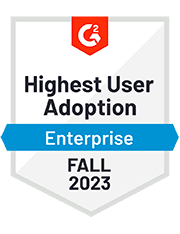Digital transformation is expected to deliver both operational and financial results within 18 months on average” says Fujitsu’s digital transformation PACT. The biggest drivers of this transformation are the customers by 58%.
How can my company start going digital today? Tough one.
If 85% of companies are putting a digital strategy together, only 26% allocate a specific budget to it. In our digital era, they are deadly wrong.
“Big companies decided not to be a part of companies that are going to disappear in less than 10 years […] They have no choice but to reinvent themselves.” Pascal Buffard, CEO of Axa Technology Services and VP of Cigref.
The thing to do would be to reinvent ourselves in the way we do business, sounds easy enough right? Except that, just like we said in our last article, the ways to do so are not always obvious when you keep one’s nose to the grindstone. It is quite difficult to harness the digital opportunities working for the company that wants to capitalize on these opportunities.
Starting your digital transformation can be like starting this article, we never know where to begin.
What are the best (and worst) practices that can be activable today? Down below is a table of the seven methods that have been successful so far, or not. (Special thanks to the wonderful Aurélie Wen who put this table together, please find the ranking method at the bottom of this article)
Studies show that as businesses… We all need to be customer-centric, and data-centric, and mobile-centric, and digital-centric, and employee-centric.
Hum, I am starting to have a headache. Let me get another cup of organic detox tea.
That said, let’s go back to digital transformation, I would not want to stray. How do I get this done? Let’s dive into it.
Suggestion Box
It starts with a well-intentioned initiative; getting employees to share their thoughts, ideas, and suggestions to improve their day-to-day work lives.
Unfortunately, physical or digital, suggestion boxes often end up as lists of demands. Free coffee, news chairs or worst, Bob from accounting is resigning!
Other idiosyncrasy, suggestion boxes are top-down initiatives; executives make them, and they are made for executives. The counting process is opaque, and employees are not part of it. In some cases they can be counterproductive: a low rate quality ratio in the suggestions is leading to a lack of actions led by the leaders. It usually ends up in frustration and disengagement from the employees.
Corporate Social Network
Great promises: better communication between departments, friendliness between employees leading to better collaboration.
It might be accurate for digital natives but the core premise is flawed; older generations usually have a hard time joining and exchanging on the network. Implementing it might lead to them feeling left out. Think about the digital divide! The main mistake when implementing a corporate social network is imposing it.
If you make it mandatory: without a great communication on the benefits of such a tool, the network is perceived as a constraint.
If you don’t make it mandatory: what is the purpose of a company’s network if a whole bunch of employees is not using it?
Innovation Lab
HP Labs, Google’s X research center, Microsoft research lab, Oracle Labs, etc.
Two years ago, Capgemini Consulting estimated that 38% of the 200 biggest international companies created innovation labs. These labs aimed to accelerate the innovation process and identify new markets.
What is wrong with them? Three things:
- They incorporate an elite of employees and are not representative of the other people working at the company. It creates a two-tier structure: a cutting-edge lab and the rest of the organization.
- Make room for a paradox: how to be close to departments to understand their needs while isolating the lab to look for growth drivers in uncharted territories?
- This last dilemma explains their low performances: 80 to 90% of these labs fail to generate growth.
COOC
A C.O.O.C (Corporate Open Online Course) is an online training program a company offers to its employees. It is a great tool to educate new employees, upgrade seniors and enroll your staff in an on-going training. On-demand and 100% digital, the format offers flexibility to the participants while optimizing formation costs for the company.
However, employees are often passive in the courses, especially if they are not completed by physical workshops, and follow up with mentors. The learning process is too personal (they have to do it Han-style: solo ), and it results in a lack of internal collaboration. Online or offline, Ebbinghaus’ forgetting curve shows us that after six days, the retention rate drops to 25%!
Business Game
A business or serious game is the corporate version of educational games for children. It has all the advantages of a COOC but mitigates the forgetting curve.
In a business game, the employee is the main character that must act to unlock different levels. It is scientifically proven that playing increases the retention rate by introducing three engaging elements: pleasure, reward, and collaboration. Another great asset: business games are cross-generational and require almost no training.
Key point: finding the right balance between playful and educative. Be too playful and employees’ skills won’t increase. Be too educative and the game will not interest participants.
Great example:
In 2015, Accenture launched the “Accenture Superhero Collaboration Game”. During five months, the consulting company made their employees answer a 2,000 question-quiz both online and offline.
Main goal: reconnect their consultants, scattered between clients, with the company’s values and make them learn what other departments do. Challenges and quizzes, employees could make their own families participate. Humor, self-mockery and off-beat tone: great elements from leaders that contribute to this thriving business game.
Internal Hackathon
Hackathon is a contraction of ‘hack’ – a quick DIY solution to overcome a problem – and ‘marathon’ – a long-distance event that tests participants’ stamina. It is a competition that encourages participants to put forward their most relevant and innovative solutions to a business issue.
The organization behind internal hackathons is simple: the company identifies one or several issues to overcome using its employees’ collective intelligence. Creation of a new product, development of an innovative marketing campaign or redesign of the office to promote well-being at work.
The business then invites its employees to work in teams to put their best ideas forward. Throughout the event, employees have access to in-house or external mentors who provide coaching to help them take their views as far as possible.
Finally, a jury assesses and grades the proposals to determine the winning teams, generally during a seminar-style corporate event.
Hackathons are an outstanding asset for companies that are looking to boost their digital transformation, providing six main benefits:
- Through crowdsourcing, the company can identify its in-house talents with intrapreneurial potential, and ideas that could be a game-changer for their business.
- Participants have the opportunity to boost their creativity to help the organization’s growth.
- By encouraging teams from different departments to work together, hackathons help to break down silos between units.
- Through hackathons, employees become more intimate with new digital tools without negative effects – in fact, it’s an asset that helps them to stand out. The best way to learn is through action, and hackathons are the ideal environment for learning by doing.
- They encourage healthy competition between teams thanks to their focus on coopetition (cooperative competition), and on collaborative innovation which emphasizes collective intelligence.
- They help your teams become stronger by focusing their energy on creative problem-solving rather than on the problems themselves.
However, it exists dos and don’ts concerning the organization of a hackathon. Make sure to download our ebook on the subject; it is pretty solid!
Intrapreneurship Program
Intrapreneurship programs are logical follow-ups to hackathons. Involving the most motivated and talented people within your company is a game-changer. Intrapreneurs must have a high entrepreneurial spirit (Duh.) that is going to change the company’s mindset along its culture.
Why are there so few companies doing it?
It needs a high engagement from involved people (top management and employees), not to mention a financial investment. Such programs are potent ways to boost any company’s digital transformation. As a contract between a company and its most adventurous employees, it’s a chance for the business to retain its robust talents and for the intrapreuneur to set up a business without giving up the security of being a salaried worker.
La Poste Group understood this in 2016. We worked together to reveal 20 internal startups from different backgrounds and departments. These 20 startups are currently at the acceleration stage and, if all goes well, are set to be incubated within the group.
We did the same for Publicis revealing 90 startups, check it out.
Scoring Method
Since 2011, we have observed and supported major groups and SMEs in their quest for innovation. It has allowed us to identify the six key success factors that are part of the best approaches for digital transformation:
Management involvement
Management teams are heavily involved in the process through their investments (time and budget), practical measures, and open-mindedness.
Employee involvement
Employees want to make personal and intellectual investments and devote a portion of their time to the project.
Impact on employee satisfaction
The approach has a positive impact on employee morale and well-being by developing their skills and their trust in their peers.
Building loyalty among talent
The approach allows the company to retain and build loyalty among its best employees.
Training for and adapting to the digital world
The practice is a way of training employees and is an effective method of allowing them to acclimatize to new digital tools.
Teamwork
There is a focus on teamwork, which helps to break down barriers between departments and business lines.
Going Digital: your employees before everything else
Going digital is a process of continuous change, driven by management’s vision and market pressure. Without a total commitment from the top management team, a company’s digital transformation will fail. In the same way, the digital world has irrevocably changed consumer purchasing behavior, meaning companies need to organize themselves differently.
But there’s a third key factor that’s missing – employees. Without them, there can’t be any digital transformation. Whichever technique you choose, make sure that you get all of your staff on board. Ultimately, the best approach to going digital is one that allows top management and employees to disrupt their own company – together.











